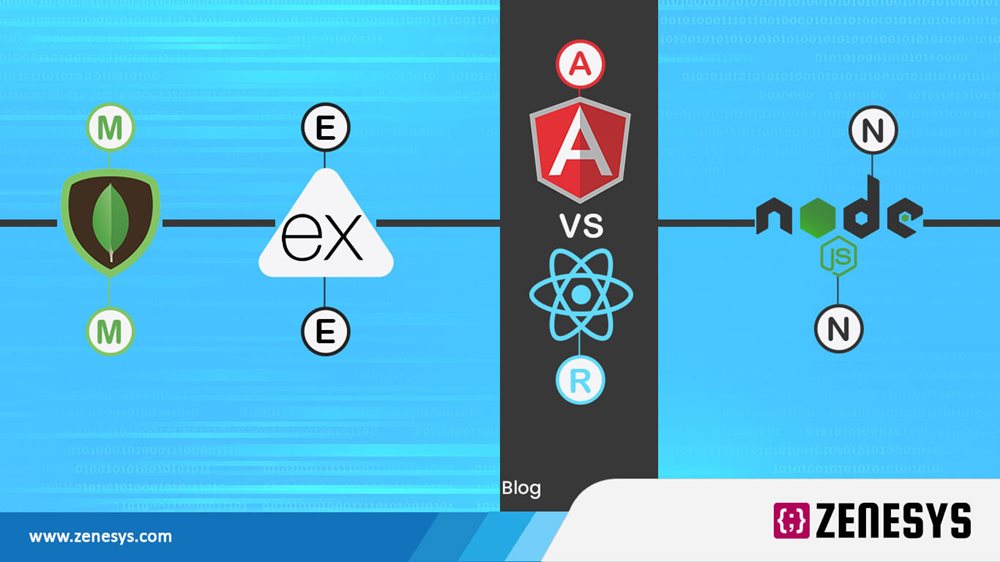When deciding on the right technology stack, you need to be intelligent enough to compare MEAN Vs. MERN stack to determine which one will work better for your business? Thus, for a complete understanding, try to dig deep into similarities, contrasts, and perks. Henceforth, pick one accordingly.
So let’s start by learning about the MEAN stack and MERN stack first!
What Is Mean Stack?
MEAN stands for MongoDB, ExpressJS, AngularJS, and Node.js.Mean is an open-source and free JavaScript framework that offers swift and easy development.
MEAN Stack Components Breakdown
- MongoDB:
A NoSQL document database that stores data in flexible, JSON-like documents. It provides horizontal scaling capabilities and handles large volumes of unstructured data efficiently.
- ExpressJS:
A minimal web application framework for Node.js that provides HTTP utility methods and middleware for creating APIs and web applications quickly.
- Angular:
A TypeScript-based framework developed by Google that creates single-page applications with powerful features like two-way data binding, dependency injection, and modular architecture.
- Node.js:
A JavaScript runtime environment that executes JavaScript code server-side, enabling full-stack JavaScript development.
Why Choose MERN Stack?
MERN stack offers flexibility and rapid development capabilities, making it particularly attractive for modern web applications and startups focused on quick time-to-market.
MERN Stack Advantages
- Component Reusability:
React's component-based architecture allows for building reusable UI elements, reducing development time and maintenance overhead.
- Virtual DOM Performance:
React's virtual DOM provides faster rendering and better performance compared to traditional DOM manipulation.
- Large Ecosystem:
Extensive library ecosystem and community support provide solutions for virtually any development requirement.
- Learning Curve:
React has a gentler learning curve compared to Angular, making it easier for developers to adopt and master.
What Is MERN Stack?
MERN stack represents MongoDB, ExpressJS, React, and Node.js. This modern JavaScript stack combines the same backend technologies as MEAN but uses React instead of Angular for frontend development.
MERN Stack Components Breakdown
- MongoDB:
Identical database solution as used in MEAN stack.
- ExpressJS:
Same backend framework as MEAN stack.
- React:
A JavaScript library developed by Meta (Facebook) that builds user interfaces through reusable components and virtual DOM manipulation.
- Node.js:
Identical runtime environment as MEAN stack.
Why Choose Mean Stack?
MEAN Stack provides various libraries, frameworks, and reusable modules within the stack for business benefits in terms of development speed. The MEAN Stack is ideal for start-ups due to its structured approach and enterprise-ready features.
MEAN Stack Advantages
- Enterprise-Grade Structure:
Angular's opinionated framework provides clear project organization, making it suitable for large teams and complex applications.
- Built-in Features:
Angular includes routing, forms handling, HTTP client, and testing utilities out of the box, reducing the need for additional libraries.
- TypeScript Integration:
Angular uses TypeScript by default, providing static typing, better IDE support, and improved code maintainability.
- Google Backing:
Long-term support and regular updates from Google ensure framework stability and enterprise adoption.
Mean V/s Mern Stack: Which One To Choose?
CRUCIAL FACTORS INFLUENCING THE FINAL DECISION
- MAINTENANCE AND IMPROVEMENT:
Entrepreneurs prefer to hire React developers over Angular developers when choosing between the two top frameworks. Thus, consider employing the MERN Stack if you have a large modification pipeline for your app and long-term maintenance needs. For eCommerce projects, the MEAN Stack is an ideal choice due to its structured approach and built-in security features.
- UI REQUIREMENTS:
MERN is your go-to framework for sophisticated yet easy UI rendering for your application. It can quickly create and display screen frames for smooth user interaction through its virtual DOM implementation.
- THIRD-PARTY SUPPORT:
Another thing to consider while working on enterprise-level apps is that you can easily use third-party libraries. MEAN uses Angular, which provides built-in functionality for making HTTP calls and connecting to the backend. React, on the other hand, comes with additional libraries that perform the same functions. Third-party extensions are handled by MEAN in a plug-and-play fashion, whereas MERN requires additional setup configurations.
- SECURITY AND SCALABILITY:
Both the MERN and MEAN stacks offer enterprise-grade security features. However, each approach has distinct advantages depending on your security requirements and scalability needs.
Architecture Deep Dive: Understanding the Technical Foundation
Component Architecture Patterns
MEAN Stack Architecture: Angular implements hierarchical dependency injection and follows the Model-View-Controller (MVC) pattern. Applications are structured with services, components, and modules working together through Angular's opinionated framework architecture. The real DOM approach means every UI update requires scanning the complete HTML tree structure.
MERN Stack Architecture: React uses component composition patterns with unidirectional data flow. The virtual DOM creates a lightweight copy of the actual DOM, updating only changed elements rather than the entire tree. This modular approach allows for greater flexibility in application structure and component reusability.
Performance Benchmarks with Real Data
- Bundle Size Analysis:
React applications typically generate bundles around 42-46KB compressed, while Angular applications average 92-130KB compressed. This size difference directly impacts initial loading times, with React applications loading approximately 30-40% faster in most scenarios.
- Memory Usage Patterns:
Angular applications consume 150-400MB of memory during runtime due to dependency injection and two-way data binding watchers. React applications use more efficient memory allocation, typically consuming 25-35% less memory through virtual DOM optimization.
- Development Performance:
Studies show organizations using MERN stack experience approximately 50% faster development cycles compared to traditional solutions, primarily due to JavaScript uniformity across the entire stack.
Enterprise Security Framework Analysis
Built-in Security Features
Angular Security Advantages: Angular provides built-in CSRF (Cross-Site Request Forgery) protection, sanitization services, and HTTP interceptors for authentication. The framework includes security best practices by default, making it suitable for enterprise applications requiring strict security compliance.
React Security Considerations: React requires additional configuration for security features. Developers must implement security measures manually, including CSRF protection, input sanitization, and authentication flows. However, this flexibility allows for customized security implementations tailored to specific requirements.
Authentication and Authorization
Both stacks support modern authentication patterns including JWT (JSON Web Tokens), OAuth 2.0, and session-based authentication. Angular's built-in HTTP client simplifies API integration, while React requires third-party libraries like Axios for similar functionality.
Development Cost Analysis with Market Data
Salary and Resource Costs
Developer Availability and Costs:
- MERN Stack Developers: Entry-level $3.5-6 LPA, Mid-level $6-12 LPA, Senior $12-20+ LPA
- MEAN Stack Developers: Entry-level $4-5 LPA, Mid-level $8-15 LPA, Senior $15-25+ LPA
Project Development Estimates: MERN projects typically cost $15,000-$30,000 for MVP development, while MEAN projects range $70,000-$150,000+ due to longer development cycles and steeper learning curves.
Time-to-Market Considerations
React developers are more readily available in the market compared to Angular specialists, reducing hiring time and costs. The simpler learning curve of React allows teams to onboard developers faster, contributing to shorter project timelines.
Modern Development Ecosystem Integration
TypeScript Adoption Impact
TypeScript adoption has reached 70-75% among JavaScript developers in 2025. Angular uses TypeScript by default, providing immediate benefits for large-scale applications. React projects increasingly adopt TypeScript, with over 60% of new React projects incorporating static typing.
Framework Ecosystem Statistics
- React: Maintains 39.5% usage among developers and 82% according to State of JS 2024
- Angular: Holds 17.1-22.96% market share across various surveys
- React Downloads: Exceed 15 million weekly on NPM, while Angular averages 2.5 million
Mobile Development Extensions
React Native Integration: MERN stack applications can extend to mobile platforms using React Native, sharing up to 70% of codebase between web and mobile applications.
Ionic Framework: MEAN stack applications can leverage Ionic for hybrid mobile development, though this requires learning additional framework concepts beyond Angular.
Performance Optimization Strategies
Code Splitting and Lazy Loading
React applications benefit from built-in code splitting capabilities, allowing developers to load components on demand. Angular provides lazy loading modules but requires more configuration to implement effectively.
Server-Side Rendering (SSR)
Next.js (React-based) offers superior SSR capabilities out of the box, while Angular Universal provides similar functionality but with additional setup complexity. SSR improves SEO performance and initial page load times significantly.
Future-Proofing and Technology Trends
Framework Longevity and Support
Google's continued investment in Angular ensures long-term enterprise support, while Meta's backing of React provides stability for the open-source ecosystem. Both frameworks receive regular updates and maintain backward compatibility effectively.
AI and Machine Learning Integration
Both stacks support AI/ML integration through various libraries. React's flexibility makes it easier to integrate experimental AI tools, while Angular's structured approach provides better patterns for enterprise AI implementations.
Migration Strategies and Considerations
MEAN to MERN Migration
Organizations migrating from MEAN to MERN typically see 20-30% performance improvements and reduced maintenance overhead. The migration process involves replacing Angular components with React equivalents while maintaining the same backend infrastructure.
Gradual Adoption Approaches
Teams can adopt incremental migration strategies, starting with new features in the preferred framework while maintaining existing functionality in the current stack.
When to Choose MEAN Stack?
- Enterprise Applications:
Choose MEAN when building large-scale enterprise applications requiring structured development patterns, built-in security features, and long-term maintainability.
- Complex Business Logic:
Angular's dependency injection and service architecture excel in applications with complex business requirements and multiple data sources.
- Team Structure:
MEAN works well with larger development teams where code organization and consistent patterns are essential.
- Regulatory Compliance:
Applications requiring strict security compliance benefit from Angular's built-in security features and Google's enterprise support.
Want to build dynamic and scalable web apps with AngularJS?
At Zenesys, we specialize in delivering robust AngularJS development solutions that accelerate your business growth.
Get Started TodayWhen to Choose MERN Stack
- Rapid Prototyping:
Choose MERN for quick MVP development, startups, and projects requiring fast time-to-market.
- Modern UI Requirements:
React excels in creating interactive, dynamic user interfaces with smooth animations and real-time updates.
- Cross-Platform Development:
MERN enables easy extension to mobile platforms through React Native code sharing.
- Flexible Architecture:
Projects requiring custom architecture patterns and flexible component structures benefit from React's unopinionated approach.
Need a fast, interactive user experience with ReactJS?
Zenesys crafts high-performance ReactJS apps to help you stand out and scale seamlessly.
Let’s Build TogetherFinal Words
Frequently Asked Questions (FAQ)
1. What is the main difference between MEAN and MERN stack?
The key difference is in the frontend framework: MEAN uses Angular, while MERN uses React.
2. Which stack is easier for beginners to learn?
MERN is generally considered easier to learn because React has simpler syntax and more accessible documentation, while Angular has a steeper learning curve due to its comprehensive features and TypeScript requirement.
3. Which stack should I choose for enterprise-grade applications?
MEAN stack is favored for large, complex projects with many contributors, especially in sectors like banking and healthcare, largely due to Angular's opinionated structure and strong security features.
4. Is MERN better for faster development and prototyping?
Yes, MERN stack allows for quicker development cycles and is particularly suited for startups and MVPs, thanks to React’s component reusability and large developer pool.
5. What are the community support differences?
Angular (MEAN) has a more mature and well-established community, whereas React (MERN) has explosive growth and a highly active pool of contributors.
6. Which stack is better for building mobile apps?
React’s ecosystem supports React Native for mobile app development, enabling high code reuse between web and mobile apps, which is a common choice for MERN stack users. Angular/Ionic is available for MEAN stack but requires learning more framework concepts.
7. Which stack provides better performance for UI rendering?
MERN stack (React) typically offers smoother and faster UI rendering due to virtual DOM implementation, while MEAN stack (Angular) performs best for complex, structured business logic and heavy server-side tasks.
8. Does MEAN or MERN offer superior security features?
MEAN stack offers built-in security features with Angular and TypeScript, which reduce common JavaScript-related vulnerabilities. MERN stack can be made secure, but requires more manual configuration.
9. Can both stacks handle large-scale projects?
Both stacks are scalable, but MEAN stack is typically preferred for large enterprise solutions due to Angular's modular architecture and maintainability advantage.
10. What about third-party library support?
Angular provides ready-to-use third-party libraries and features for enterprise integrations, while React’s ecosystem offers a vast array of libraries—with MERN, additional configuration is needed for seamless integration.


.webp?lang=en-US&ext=.webp)

.webp?lang=en-US&ext=.webp)

